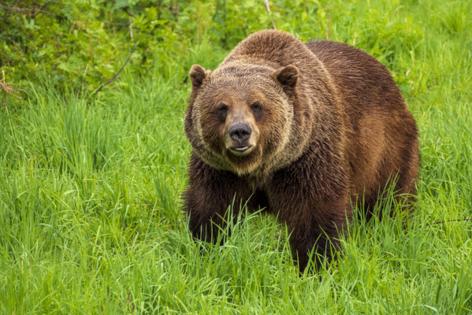Feds greenlight return of grizzlies to Washington's North Cascades
Published in Science & Technology News
SEATTLE —Grizzly bears will soon return to the North Cascades.
The National Parks Service and U.S. Fish & Wildlife Service filed a decision Thursday outlining a plan to capture three to seven grizzlies from other ecosystems in the Rocky Mountains or interior British Columbia and release them in the North Cascades each summer for five to 10 years. The goal is to rebuild a population of 200 bears in a century. In the Lower 48 states, the bears are a threatened species under the federal Endangered Species Act.
The agencies plan to designate the bears as a "nonessential experimental population" to provide "greater management flexibility should conflict situations arise."
Under this designation, some of the rules under the Endangered Species Act are relaxed, allowing people to harm or kill the bears in self-defense, or for agencies to relocate bears involved in conflict. The designation will allow landowners to call on the federal government to remove bears if they pose a threat to livestock, for example.
"[The rule] provides an expanded set of management tools in recognition that grizzly bear recovery in the North Cascades is dependent on community tolerance of grizzly bears," Brad Thompson, state supervisor for the U.S. Fish & Wildlife Service, said in a statement.
Grizzlies for thousands of years roamed the North Cascades, from the temperate rainforests of the west to the dry ponderosas and sagebrush east of the crest.
That is, until white settlers arrived and wiped the bears off the landscape. Beginning in the mid-1800s, they killed more than 3,000 for their pelts while miners and homesteaders killed countless others. There have been no verified sightings of the bears in the U.S. portion of the North Cascades since 1996, south of Glacier Peak.
Place names in the North Cascades recognize Indigenous peoples' long coexistence with the bears. Stetattle Creek was derived from stəbtabəl' (stub-tahb-elh), or grizzly bear, in the Lushootseed language spoken by the Upper Skagit people who lived on these lands for at least 10,000 years.
After years of advocacy, the Upper Skagit Tribe is looking forward to the bears' return to the rugged North Cascades that Upper Skagit people previously shared with grizzlies for thousands of years, said Scott Schuyler, policy representative for the tribe, earlier this year.
"The Upper Skagit celebrates this decision for the great bear, the environment, and everyone who desires a return to a healthy Indigenous ecosystem," Schuyler said in a statement. "We urge the agencies to move forward and put paws on the ground so the recovery may begin."
A keystone species, the bears are known to till and aerate soil as they search for potato-like roots like Alpine sweetvetch, munch on berries, and later deposit the seeds through their scat. The omnivores love to snatch salmon from the river and will steal kills from other predators.
Studies have suggested the North Cascades can support up to about 280 bears — but when considering the effects of climate change, that number rises to as many as 578 bears, according to the federal agencies. Projected declines in snowpack would result in a decrease in vegetation at the highest elevations, but also an increase in grizzly bear foraging habitat in high-elevation meadows.
Grizzly bears with no history of conflicts with humans and a berry-based diet will be captured from multiple areas and released between June and September, of each year, if everything goes according to plan. The bears would be captured using culvert traps and transported by truck and trailer to staging areas. From there, they would be transported by helicopter to remote places like the Stephen Mather, Pasayten and Glacier Peak wilderness areas.
Some of the best intact grizzly habitat remains here. The U.S. portion of the North Cascades ecosystem is roughly 9,800 square miles, and includes habitat for dens and hundreds of species of plants, animals and insects the bears feast on. Roughly 85% of the mountainous region is under federal management.
"We are going to once again see grizzly bears on the landscape, restoring an important thread in the fabric of the North Cascades," Don Striker, superintendent of North Cascades National Park Service Complex, said in a statement.
The effort to return grizzlies to the North Cascades has been a yearslong on-again off-again effort. And it hasn't been without controversy.
In 2022, the federal agencies initiated the latest effort.
In the fall, the agencies offered three options for the bears' future in the North Cascades: to do nothing, or to reintroduce bears to the area under different levels of federal protection.
During the 45-day public comment period for the draft document, the agencies received over 12,000 public comments. And hundreds of people commented at public meetings across the region. The document containing responses to public comments is over 100 pages.
Some commenters were concerned about human-bear confrontations, and objected to the comparison of the North Cascades to other grizzly recovery zones.
The federal agencies responded that the goal population for the North Cascades is substantially less than the population in both Yellowstone and Glacier national parks and the probability of conflict would be less than in those parks.
In Yellowstone, seven people have been killed by the bears since the park was established in 1872.
The agencies also responded to concerns about grizzlies' impacts on livestock, and on threatened species like wolverines and salmon, as well as hikers.
Ultimately, federal agencies landed on a reintroduction plan that relaxes the protections granted under the Endangered Species Act, and allows officials to intervene if human-bear conflicts arise.
The nearest grizzly populations to the east are in the Selkirk Mountains in Washington, Idaho and British Columbia and the Kettle-Granby population unit in B.C. There are smaller numbers of the bears to the north in the Stein-Nahatlatch population unit, and west in the Squamish-Lillooet and Garibaldi-Pitt population unit.
Highways, rivers, railroads and human influence fragmenting the habitat make it unlikely the bears would naturally repopulate the North Cascades.
Previous federal estimates suggest it could cost up to $140,000 per year to capture and transport bears, up to $200,000 for monitoring in the first year of the program, and another $250,000 for staff costs.
There is no set timeline for when translocation of grizzly bears to Washington might begin. The National Park Service will publish updates on the park website and notify partners and the public of plans as they develop.
©2024 The Seattle Times. Visit seattletimes.com. Distributed by Tribune Content Agency, LLC.







Comments